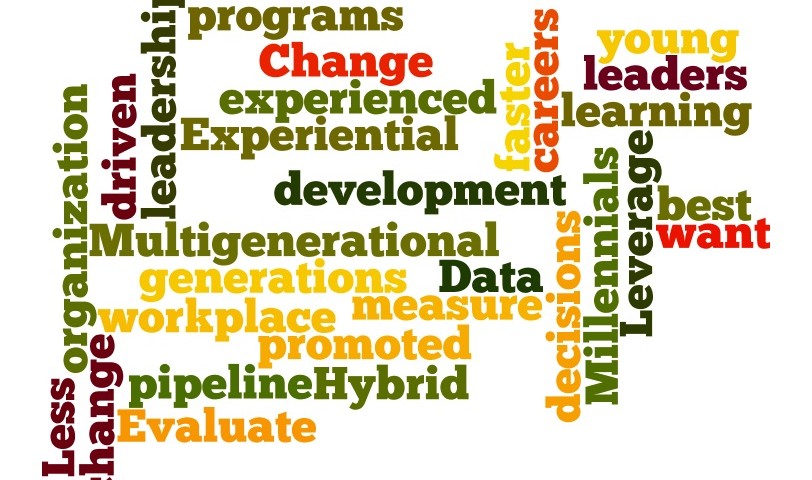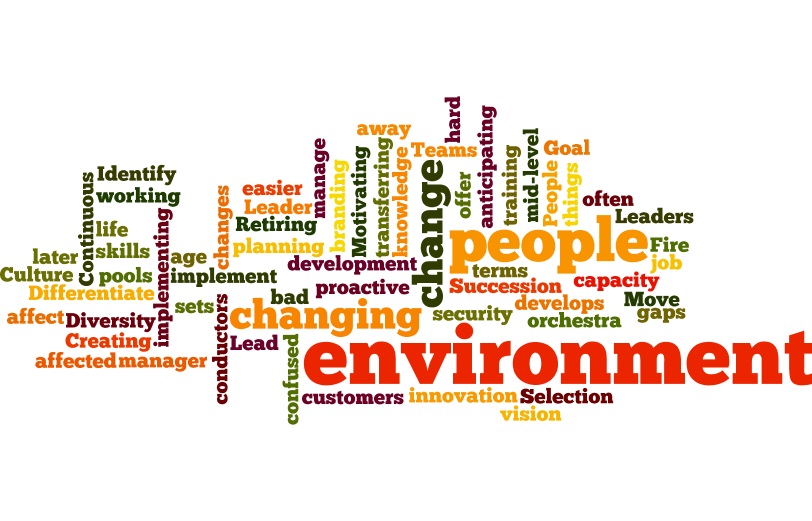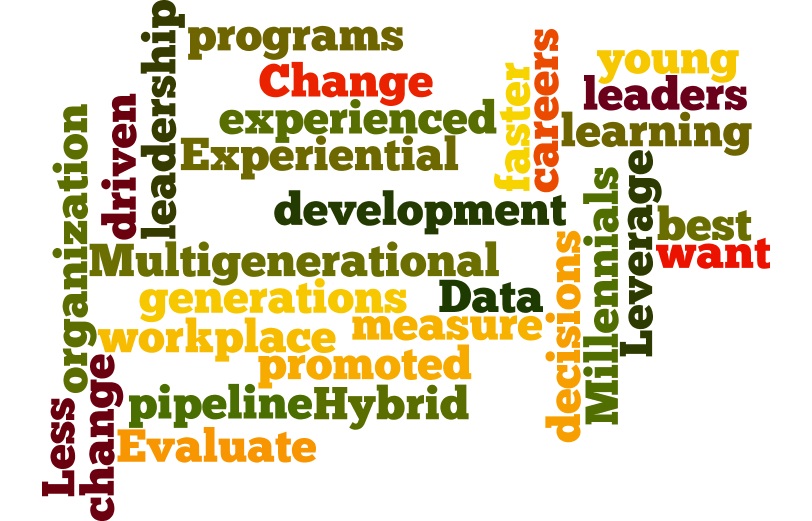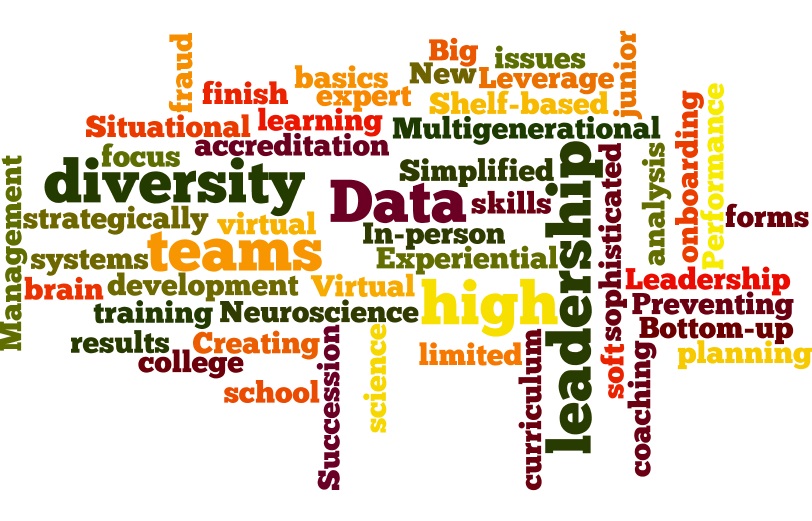2016 Predictions for Leadership Development
COLLABORATION (noun) “The action of working with someone to produce or create something”
February 9, 2016
Advancing Teamwork Across Disciplines
February 23, 2016To ring in 2016, ATD’s Leadership Development Community of Practice gathered to share a potluck of appetizers and predictions for the future. The evening began with a look back at 2015 and our hard-won lessons learned. Then we each made a prediction for 2016. The Wordle images below provide a glimpse of what our group of passionate leadership developers are thinking as 2016 gets underway. If you prefer a more linear view, check out the lists of lessons learned, trends, and predictions at the end of this post.
2015 Lessons Learned
Trends
Predictions
Notable Quotes
Here are my favorite quotes from the evening. Apologies for the lack of attribution for two of them.
“Leadership is capturing a dream we can all relate to.” –Gabe Hamda
“Leaders need to develop a palette of skills to draw on.”
“Leaders help people make mistakes and learn from them.”
Bonus Predictions
Our discussion was so robust, and so many people wanted to share their perspectives that Alok and I, who were facilitating and scribing, never got a chance to give our predictions. We promised the group that we’d do so here. So as a bonus, here are two more sets of predictions.
Alok’s Predictions:
- Expansion of Virtual Teams: Based on a survey conducted by SIOP recently, work is becoming more about “what” you do rather than “where” you do it. Virtual teams will increase rapidly in 2016 and engaging employees who are not in the same location will be a challenge for employers. This will also have implications for personnel selection. In recruiting, will employers now look for employees that are more engaged in their work vs. work environment?
- Overhaul of Performance Management: Will the performance management systems go through significant changes? More organizations seem to focus on the “developmental” aspect of performance management that fosters collaboration as opposed to forced distribution and rankings of their employees that promotes competition. Perhaps, and in addition to the supervisor who provides performance feedback, many employers will begin to think about a coach-like person who can provide developmental feedback.
- Resurgence in Employee Engagement: Many employers are starting to realize that engaged employees are not only productive employees, but these employees can go beyond their “job descriptions” to help their co-workers (and divisions and company) when needed. For example, these are the people who care and are committed to their organizations. Can employers select these kinds of individuals? Absolutely yes! There are many shelved and tailored assessments that can be administered to select individuals who are more likely to be engaged in their work.
Claudia’s Predictions
- Helping the Overwhelmed Employee: Current research from Deloitte indicates that “more than two-thirds of all organizations believe that their employees are “overwhelmed” with too much information, too many projects, too many meetings and phone calls, and an always-on 24 X 7 work environment.” This theme also comes up in Josh Bersin’s predictions for 2016. Being overwhelmed affects employees’ health. It keeps them from developing new skills and knowledge. And it takes away from families and communities. It can lead to broken relationships and half-baked solutions. In 2016, leaders must address this issue by simplifying workplace operations and helping employees focus.
- Gaming for Leadership Development: Gaming and gamification of learning have been frequent topics in recent blogs and articles. And research shows that there are many good reasons for using games for leadership development. Only games are able to emulate accurately the complex interconnected environment in which leaders operate. Gaming environments allow leaders to practice and apply multiple competencies simultaneously, and since they have fun doing so, they’re willing to practice more often. So, look for more gaming options for leadership development.
- ReImagining Learning: In his predictions for 2016, Bersin foresees significant disruption in corporate learning: “Employees are now in charge, video learning is everywhere, and hundreds of new learning tools and platforms are entering the market.” Many articles have been written about the need for change in learning and development. However, often organizational institutions and structures stop change from occurring. Technology gives us myriad options. Learning leaders need to guide clients and create environments that allow for new approaches for learning and performance support–for leadership development and all kinds of learning.
The Linear Lists:
2015 Lessons Learned
- There’s no such thing as job security
- Better to fire a bad customer (bad fit)
- Be proactive in anticipating change and transferring knowledge
- Motivating people to implement change is hard (planning is easier than implementing)
- Leaders have to see themselves as orchestra conductors
- Creating an environment for innovation
- In large organizations, move away from branding
- Organizations need to create succession pools and they’re not prepared
- Training isn’t the only answer (selection is important too)
- Training needs to be continuing
-Engagement
-Like military, sports, blue collar - Need to differentiate between terms that are often confused
-Learning, training, education
-Consulting, coaching - Identify skills gaps and offer development
- Leader sets the capacity (vision); manager develops
- Culture changes at the mid-level
- Lead people; manage things
- People working later in life: changing environment
- Goal and environment changing: how people are affected and how they affect the environment
- People retiring at age 30
- Things happen in teams
- Bring in diversity to make a better widget
Trends:
- Young leaders (less experienced) don’t know hot to work with consultants
- Multigenerational workplace: Leverage the best of all generations
- Organizations asking to evaluate/measure leadership development programs
- Millennials want to be promoted faster
-What’s the backward path if they don’t succeed
-How do we recognize potential - Change the pipeline, change the organization
- Hybrid careers
-Intense training
-Job with high salary - Data-driven decisions
- Experiential learning
-Evaluating so get credit
Predictions
- Big Data
-How to quantify
-What’s the problem
-Data analytic teams - More coaching, but limited results
- Coming together as a team vs. virtual work
- Situational leadership will make a comeback
- New forms of Performance Management
-Turn upside down
-Difference between metrics and measurement - More creativity in creating diversity
- Experiential learning
- More virtual teams
-Better virtual technology
-Better satisfaction
-Better engagement - People need to be together for soft skills
- Succession planning
-Companies that don’t do this will fall off the map - Increase in leadership curriculum in high school, college, and junior high
- Shelf-based expert systems
- Neuroscience and brain science
-Connect people better
-Conversational; civil discourse; intel - Leadership and Development gear up to move data analysis to the front line
- Multigenerational issues
-How to make it work - Simplified focus and finish: basics
- Preventing fraud in accreditation
-System of trust
-Place to find people with the sills we need
-Adhoc teams - Companies will realize that leadership starts at the bottom
- More sophisticated onboarding
- Leverage diversity strategically












